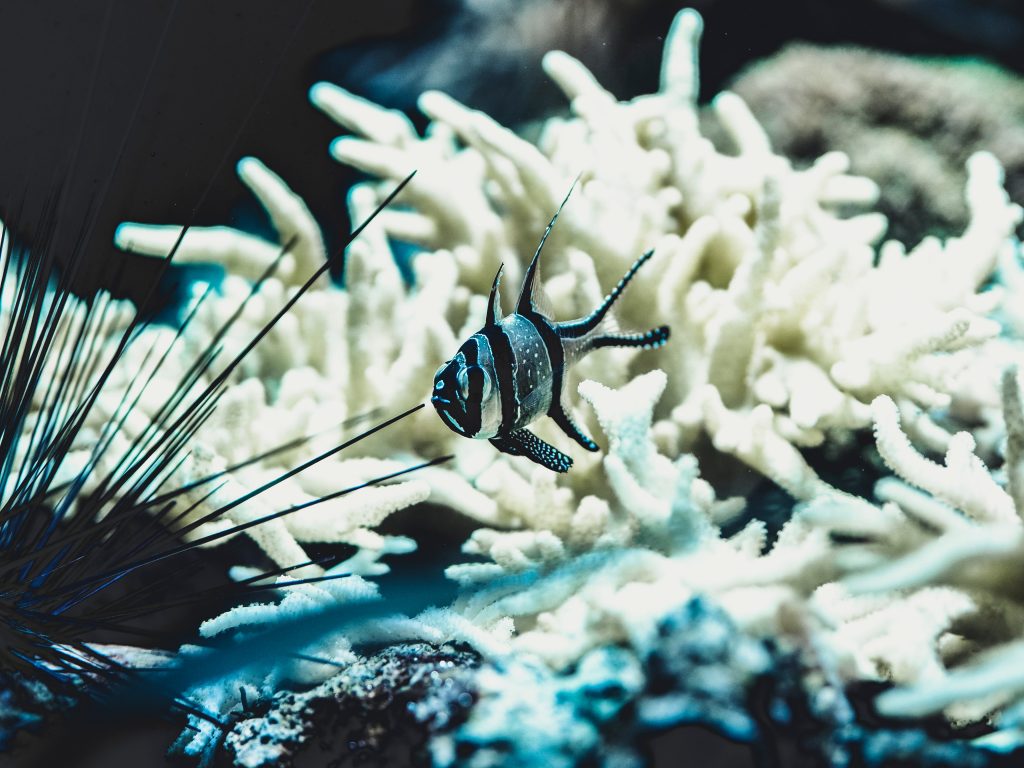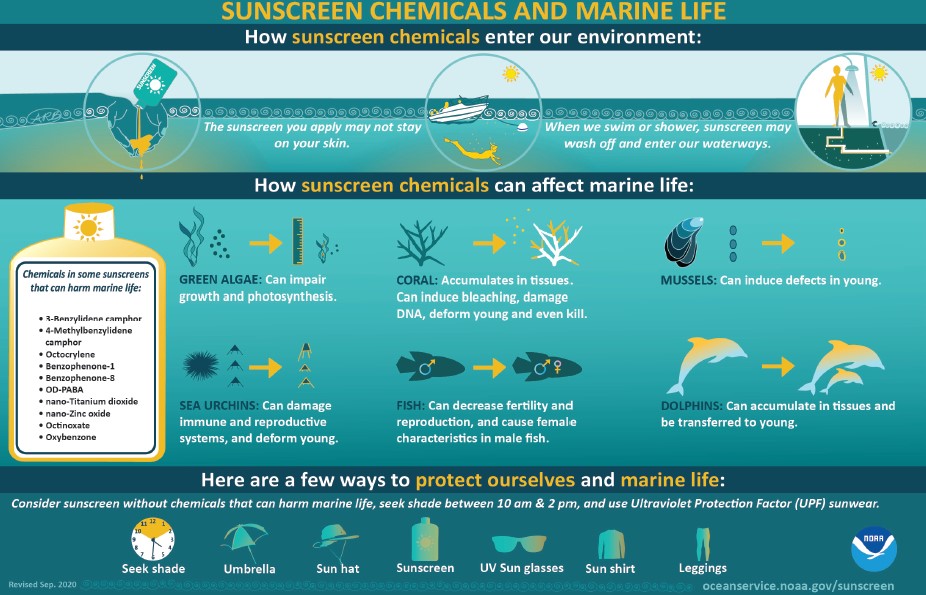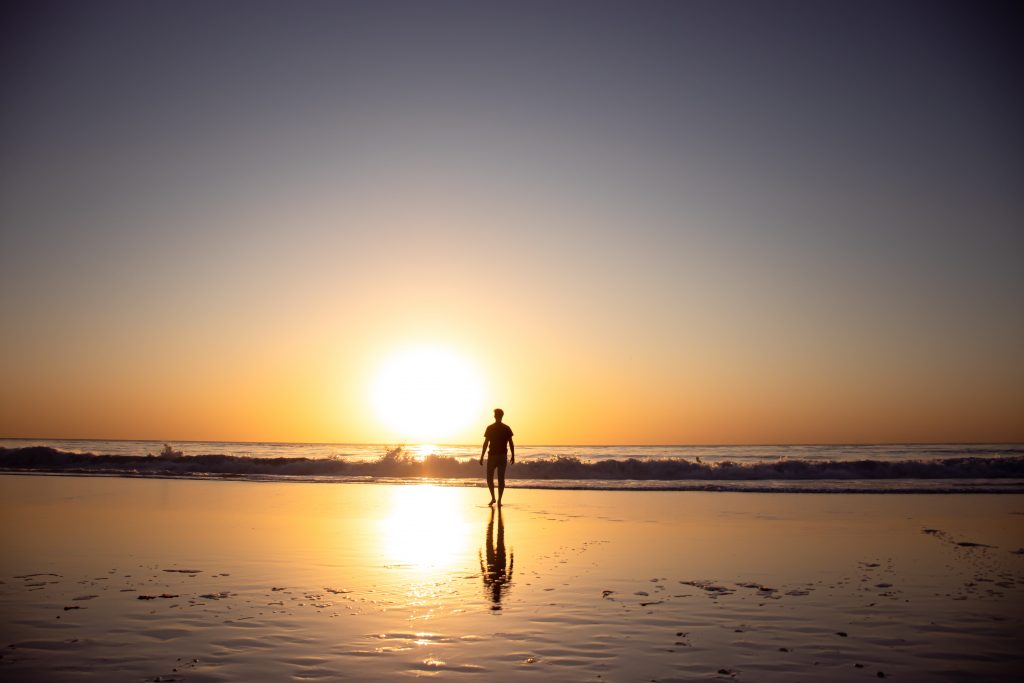Coral reefs attract boatloads of tourists each year obsessed with their natural beauty. However, most tourists are unaware that they may be contributing to the destruction of the coral they have come to admire. When you go to the beach, you probably apply sunscreen to protect your skin from the sun’s harmful UV rays. If you go for a swim, some of your sunscreens will wash off in the water. Unfortunately, many sunscreens harm coral reefs if they enter the ocean due to their UV filters (Evan T, 2017). Tourism around coral reefs has increased, and so has the amount of chemical pollution in the ocean. Let’s take a look at how sunscreen harms coral reefs, and what can be done about it.
Why are Coral Reefs Important?
Coral reefs are one of the most diverse and valuable ecosystems in the world (Taylor Glenn, 2019). They provide food and shelter for an array of marine species including sea sponges, fish, crustaceans, and turtles (Evan T, 2017). Corals protect the animals that inhabit them, acting as a barrier from storms and surge water (Taylor Glenn, 2019). All populations within the reef ecosystem are part of a larger food web, so if the corals are impacted this affects all other species.
Reefs provide nutrition not only for marine life but for humans as well. 500 million people worldwide rely on reef systems for food and income (NOAA, Coral Reefs Ecosystems, p.1, 2019). Billions of dollars (USD) in economic and environmental services such as food, coastal protection, and tourism are made from coral reefs each year (NOAA, 2020). However, these ecosystems are facing serious threats from a number of factors. One of these is the leaching of toxic chemicals from sunscreen into the oceans (NOAA, 2020).
What is Coral Bleaching and what causes it?

We’ve all heard of coral bleaching, but how does it actually occur? Corals have a special symbiotic relationship with photosynthetic algae (zooxanthellae) that live inside the corals’ tissues. The algae receive a protected environment and the nutrients needed for photosynthesis, whilst in exchange, providing oxygen and carbohydrates to the coral (Taylor Glenn, 2019). The algae also contain photosynthetic pigments that give coral their bright colours. If the coral experiences stress such as high temperature, the zooxanthellae may be expelled from the coral’s tissue (Taylor Glenn, 2019). When it leaves, the coral becomes bleached and will eventually die from a lack of oxygen and carbohydrates. The good news is that the coral won’t die straight away, and coral communities can recover from mass bleaching in 15 to 25 years (UNESCO, p.1, 2017). This means there is still hope for coral reefs that have already faced a bleaching event.
The Impact of Sunscreen on Coral Reefs

Scientists have discovered that some of the chemical UV filters found in sunscreen threaten the health of coral reefs (NOAA, 2020). A study in 2008 found that oxybenzone and octinoxate are the two main ingredients that pose a significant threat to coral and marine biota (Taylor Glenn, 2019). These chemicals from sunscreen can cause the following effects on coral reefs:
1. Coral bleaching
This effect is more pronounced at higher water temperatures (Taylor Glenn, 2019). Coral reefs are generally located in warmer climates where people regularly use sunscreen which exacerbates the impact. Research shows that approximately 4,000 to 6,000 tons of sunscreen enter reef areas annually (Evan T, 2017). This is an alarming indicator of the magnitude at which sunscreen harms coral reefs.
2. Introduction of viruses
Oxybenzone and other UV filters can cause viral infections among the zooxanthellae (Elizabeth Wood, 2018). A virus replicates when the algae host explodes. It is then free to move to nearby coral communities, spreading the infection and eventually killing all the coral in the area (Tibbetts, 2008).
3. Damage to DNA
The chemicals in sunscreen can damage the genetic makeup of the coral (Elizabeth Wood, 2018). This affects the composition of coral by increasing the frequency of mutations (NOAA, 2014). When mutations occur, they can deform the coral larvae, limiting their reproductive success (Elizabeth Wood, 2018).
UV filters reach coastal waters either directly from washing off swimmers and/or indirectly from wastewater. Many of these chemicals have been found in fish, molluscs, and sediment, showing just how much sunscreen harms coral reefs and marine life within these habitats (Elizabeth Wood, 2018).
What can be done about Sunscreen and Coral Bleaching?

To stop this damage, proactive approaches are required to decrease the use of harmful chemicals in sunscreen that harm coral reefs. Considering the many other stresses already faced by reefs, reducing the number of harmful sunscreen components that reach the ocean is a high priority. Dealing with this issue will require the involvement of governments, reef managers, divers, snorkelers and swimmers, and the tourism and pharmaceutical industries (Elizabeth Wood, 2018). Potential actions include (Elizabeth Wood, 2018):
- Encouraging the production of reef-friendly sunscreens.
- Promoting the use of non-toxic sunscreens and other eco-friendly methods of UV protection
- Regulating the sale and use of sunscreens containing toxins, especially around coastal areas
- Driving consumer pressure to encourage manufacture and distribution of affordable, eco-friendly sunscreens
- Introducing financial disincentives for development of sunscreens that harm coral reefs.
- Educate the public of the harmful effect of sunscreen on marine life
For the health of the reef, it is extremely important that we decrease and hopefully discontinue the use of non-eco-friendly sunscreens. In doing so, it will allow coral reefs to keep providing a healthy habitat for an abundance of species.
The Future of Coral Reefs
Coral reef ecosystems support a great diversity of life and are a vital source of income for many people. Unfortunately, the chemicals found in sunscreen leach into the ocean causing the destruction of coral reefs. Their ecosystem services such as tourism, and ecosystem functions including breeding grounds for marine species are just some of the reasons why it is important to save our reefs.
At THRIVE we recognise that we must find sustainable alternatives to sunscreen and implement practices to decrease the amount used. It is imperative that we preserve these reefs not only to sustain biodiversity but also to continue providing jobs, income, and services for the long term.